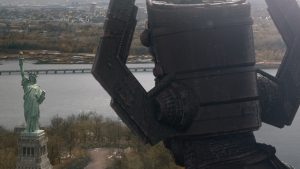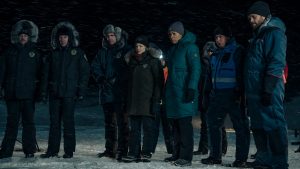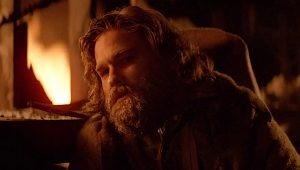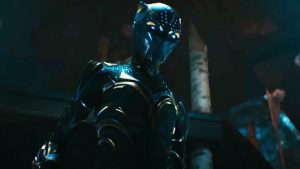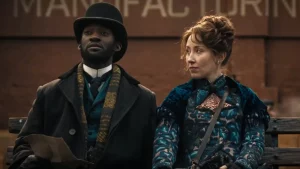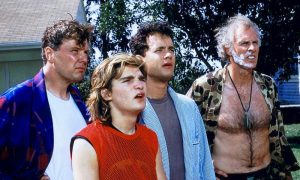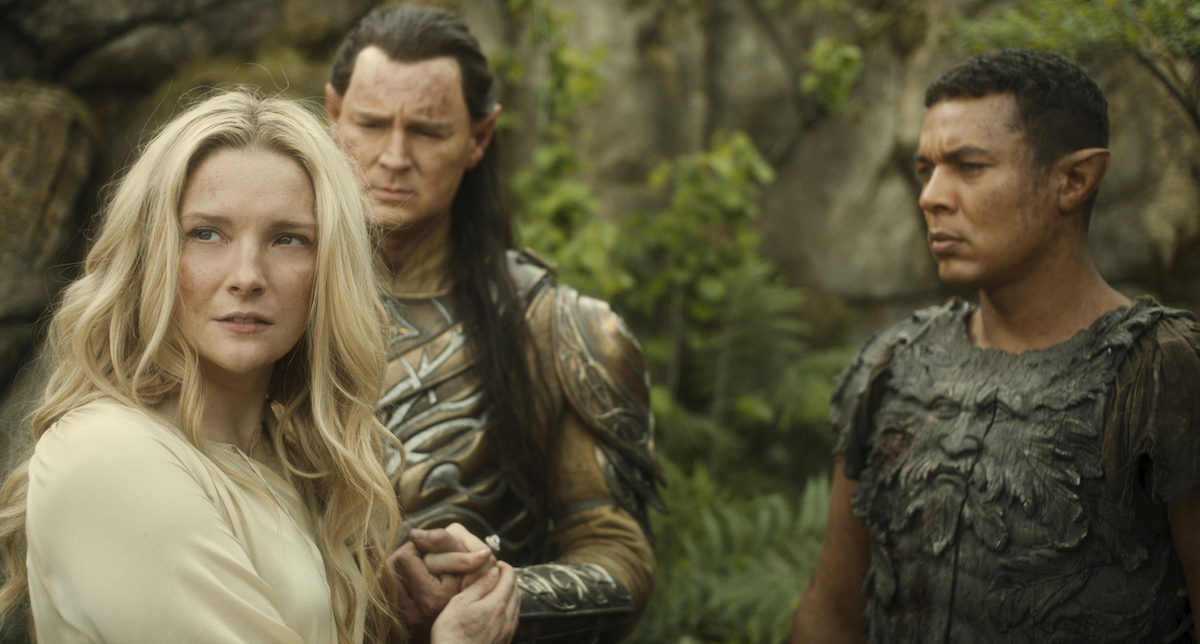
This Lord of the Rings article contains spoilers for The Rings of Power.
The Lord of the Rings: The Rings of Power season 2 finale had it all: The conclusion of a massive battle, the deaths of several major characters, a reunion between two former crushes turned outright enemies, and the long-awaited answer to one of the show’s biggest mysteries. (Yes, the Stranger is Gandalf, just as we all expected.) There’s a lot to unpack but, in many ways, “Shadow and Flame” also feels like a new beginning of sorts: For the first time, the board is fully in place when it comes to The Rings of Power’s larger story and the pieces are indeed moving.
Sauron is fully unleashed, the bulk of the rings of power are now in play, and chaos reigns across the worlds of men, elves, and dwarves. Where does this show possibly go next now that that the show is up for renewal? Here are a few of the storylines we think might come to pass in season 3 based on what we know from Tolkien’s work as well as the threads left hanging in the finale.
The Fall of Numenor
If any storyline is most likely to be included in The Rings of Power season 3, it is the Fall of Numenor. We’ve spent two seasons watching political unrest ferment in the island kingdom, and with Ar-Pharazôn having finally seized power outright while getting completely hooked on the palantir…well. It certainly doesn’t seem like that’s going to lead to anything good.
Canonically speaking, Ar-Pharazôn is the last king of Numenor, and, according to Tolkien’s writings, the island is destroyed in 3319 SA, a little over two decades before the great battle against Sauron that ends the Second Age. The timing feels relatively correct for its tragic end to be the big event that closes The Rings of Power’s third season, much the way the fall of Eregion concluded season 2.
“Shadow and Flame” ends with Ar-Pharazôn in charge, Míriel in chains, and Isildur headed home to a kingdom that looks very different from the one he left. There the Faithful, those Numenoreans who still practice the old ways of loyalty to the Valar, have all been declared traitors and arrested. Elendil is a wanted man, and Numenor is embracing an increasingly expansionist attitude, declaring martial law in Pelargir and ordering its residents to trade lumber to survive.
Per Tolkien—or rather, per Elendil, since it’s his “history” in The Silmarillion that retells much of this story—following the fall of Eregion, the Numenoreans become quite a bit more militant, frequently clashing with Sauron’s forces and ultimately taking the Dark Lord himself back to their island as a hostage. Sauron uses his power to seduce and corrupt Ar-Pharazôn—how much work can that possibly be really—quickly moving from prisoner to close advisor. (Because of course he does!)
He convinces the whole island to start worshiping Morgoth, ultimately sending them to declare war on the Undying Lands and attack the Valar themselves. You can probably guess what happens next—it does not go well, and Numenor is sunk beneath the waves. But not before Elendil and his sons lead a small band of Numenoreans to safety in Middle-earth, founding the kingdoms of Gondor and Arnor in the process.
This is a fairly religious-oriented plot for a show that’s mentioned the entire concept of the Valar maybe a half dozen times to date, so it’s unlikely that The Rings of Power will adapt this story in quite this way. (As fun as it might be to watch Ar-Pharazôn and his crew get crushed because this universe’s stand-in for God—Eru Ilúvatar— decided to physically change the shape of the world.) That Numenor will be lost to a flood, we know; it’s the question of how that flood will come to pass that’s up in the air.
Who Are the Men Who Will Become the Nazgul?
During the season 2 finale, Celebrimbor did his best to get his final creations—the nine rings of power meant for men—out of Sauron’s reach. But, despite Galadriel’s best efforts, Sauron reclaimed the rings for himself, stabbing her with his crown in the process. But now that he has them, the Dark Lord has to do something with them. And it is these rings, forged using his own blood, that will ultimately enslave their bearers completely, turning them into the infamous creatures known as the Nazgul, the nine immortal Black Riders who were Sauron’s most terrible servants.
Intriguingly, The Rings of Power will have quite a bit of creative freedom to tell this aspect of its story. Other than the fact that we know some of these ring-bearers became “Kings of Men” after they received their rings, there’s very little information about their identities or backstories. In one of his letters, Tolkien said that three of the Nagzul were former Numenoreans. And only two of the nine were ever named: the Witch-king of Angmar and Khamûl the Easterling.
The Witch-king will be familiar to even the most casual of Lord of the Rings fans. The de facto leader of the Nazgul, this is the being who boasts about no man being able to kill him, right before Eowyn of Rohan stabs him in the face. In some of his notes, Tolkien hinted that the Witch-king, whom he said was the ruler of a Northern kingdom, was one of the Nazgul who was of Numenorean origin. Unfinished Tales identifies his second in command: Khamûl, the so-called “Shadow of the East.” But that’s pretty much it.
It seems likely that many of the Nine will be new characters introduced next season. But it’s equally possible that several of them will turn out to be characters we already know in some capacity or other. Kemen’s already one of the worst humans on the show, it wouldn’t be that much of a stretch to turn him into an immortal monster, would it? Could Theo, who has already proven to have a connection to Sauron, become further corrupted under Numenor’s rule?
The Closing of the Doors of Durin
Still reeling from his father’s death, new King Durin IV is already facing his share of problems. The late Durin III, while under the influence of a ring of power, apparently made deals with the dwarf lords of the Blue Mountains, promising them vast riches that they’re now chomping at the bit to collect. Meanwhile, others are busy spreading rumors that Durin IV was not his father’s preferred heir to the throne, and other candidates are advancing claims, including his younger brother, who is busy gathering support of his own. (Considering Tolkien never explicitly mentioned Durin IV had a brother in the first place, this is certainly news to a lot of us!)
Canonically speaking, The Rings of Power has a lot of room to maneuver when it comes to the story of Durin’s reign. Tolkien didn’t write much about King Durin IV, beyond the fact that he inherited his father’s ring of power, so giving him a heretofore-unseen sibling isn’t that much of a stretch. I mean, technically, Disa doesn’t exist in the original text either, and that turned out great.
The show’s King Durin III removed his ring before jumping to face the Balrog and his own death, so presumably, it’s somewhere down in the portion of the mine that collapsed. But since The Rings of Power has leaned so hard into Durin IV’s distrust of the rings and how negatively the one he wore affected his father, it’s hard to imagine what might convince him to put one on himself. Perhaps, the political intrigue swirling through the halls of Khazad-dûm will have something to do with it. Would Durin IV wear a ring if it meant holding the dwarves together or preventing him from losing his father’s legacy? Maybe.
There’s another interesting bit of dwarf-related lore that season 3 will probably deal with: The Doors of Durin. In Tolkien’s writing, the magical western gate whose doors can be opened simply by speaking the Sindarin word for friend, was built at some point between the founding and fall of Eregion. (Real specific, right?) But, since we’ve met Narvi and witnessed Celebrimbor come up with the disappearing script that adorns the doors before his death, it seems highly likely that, in the show’s version of events we’ll see the dwarves install and/or shut them to keep Sauron’s forces at bay.
Elendil on His Own
Though chaos reigns in Numenor as The Rings of Power season 2 concludes, one key figure manages to escape Ar-Pharazôn’s grasp: Elendil. Tasked with a mission to find his destiny and a legendary sword known as Narsil, the future High King of Gondor is now firmly on his own. But probably not for long.
The blink-and-you’ll-miss-it-namedrops of his as-yet-unseen other son—who will one day rule Gondor jointly with his brother, Isildur—hint that we’ll most likely be meeting Anárion in season 3. And Miriel’s final request, that Elendil “reclaim his lordship” points our hero westward, toward the port city of Andúnië.
Canonically, Elendil is the son of Amandil, Lord of Andúnië, and leader of the Faithful. The heir to a family line whose descendants go back to the fourth king of Numenor, he’s a lot more…well, noble, than The Rings of Power has gone into detail about thus far. (In the show, he’s mostly just been portrayed as a loyal and beloved sea captain. So, surprise!) In Tolkien’s history, Elendil’s father is very much still alive at this point, and he encourages his son to prepare to leave Numemor behind. Amandil himself decides to try and sail to Valinor, to plead with the Valar to spare the Numenorean people. He’s never seen again.
Miriel’s decision to send Elendil west is likely the series trying to correct the omission of his borderline-royal heritage, and his arc will likely involve him reclaiming the support and power that come with his family birthright. He’ll also probably be gathering Faithful for their eventual escape from a sinking island, once Numenor’s doom begins.
What of Gandalf the Grey?
Then, of course, there’s the Gandalf of it all. It took The Rings of Power two full seasons to confirm that the mysterious Stranger was indeed Gandalf, the famous wizard who features so prominently in The Hobbit and The Lord of the Rings. But, since the Prime Video series has fudged the timing of Gandalf’s arrival in Middle-earth—which technically doesn’t take place until the Third Age in Tolkien’s writing—the show has opened the door to giving him an entirely new set of adventures.
The most obvious storyline, at least initially, is to continue Gandalf’s magical education at the hands of the mysterious Tom Bombadil. While the immortal being doesn’t interfere much in Middle-earth’s battles with Sauron in Tolkien’s works, on the show we’ve already seen him guiding the Stranger toward realizing his true purpose and helping him find the magical staff he will wield for the rest of the franchise. It’s not much of a stretch to imagine that he might continue in this mentor-esque role, helping Gandalf better understand and control his magical abilities. (Or, at the very least, introduce him to his haberdasher at some point.)
The season 2 finale also establishes that there’s some connection between Gandalf and the mysterious Dark Wizard who holds power in the east. Is the Dark Wizard one of the Blue Wizards who arrived around roughly the same time? We don’t yet know, but it seems more than evident that the two have some unfinished business.
Will We Finally Meet Celeborn?
Galadriel has had complex (and complicated) relationships with several men during The Rings of Power’s first two seasons. From her deeply emotional connection with the human Halbrand—who turned out to be Sauron in disguise, whoops—to whatever weird chemistry is happening between her and Elrond, Galadriel has already had her fair share of messy pseudo-romantic entanglements. And we haven’t even met the elf she’s technically married to yet!
Though he doesn’t play a huge role in The Lord of the Rings, Galadriel’s husband Celeborn is an important figure throughout Middle-earth history. He fought in multiple major battles, most notably the War of Wrath that expelled Morgoth from Arda. In Tolkien’s writings, he and Galadriel met and married during the First Age, and had a daughter, Celebrian, early in the second. They lived in both Lindon and Eregion, and Celeborn played a key role in defending the city during the siege of Sauron’s forces, helping elves escape alongside Elrond. On the show, Celeborn is missing—in season 1’s “The Eye” Galadriel tells Theo that her husband never came home from the War of the Great Jewels and is presumed dead.
Given that we all know there’s no way Celeborn is really dead—particularly since it doesn’t appear that Celebrian exists yet—the question becomes: when will he finally appear on the show? Could we see him in season 3? Odds are decent.
With everything Galadriel has been through emotionally since she last saw him—falling in love or something like it with her worst enemy, nearly dying, watching Eregion burn—she’s hardly the wife he left. Watching them reacclimate to one another would allow us, as viewers, to invest in their relationship alongside them. Plus, gosh, doesn’t Galadriel deserve to have something good happen to her for once?
The Remodeling of Mordor
With Sauron now fully in control of both Mordor and Adar’s former orc followers, the Dark Lord can get to work on turning the area formerly known as the Southlands into his own personal dark Disneyland. This predominantly includes the construction of his terrifying tower of Barad-dûr, the greatest fortress built since the fall of Morgoth’s Iron Prison (also known as Angband) during the War of Wrath.
Per Tolkien, the building of the tower took over six hundred years, but the author wasn’t big on details about it beyond its terrifying size, color, and general sense of menace. (The name “Barad-dûr literally means “dark tower” in Sindarin, in case you thought he was being subtle about its purpose.) Also constructed during this period: The infamous Black Gate, which guarded the northern entrance to Mordor at the gap between the Ash Mountains and the Ephel Dúath (a.k.a. The Mountains of Shadow). It is, of course, the site of the last great battle of the War of the Ring.
One Ring to Rule Them All
Perhaps the biggest unknown hanging over The Rings of Power season 3 has to do with one specific piece of jewelry. There are currently 19 rings of power in existence, though nine of them, as yet, do not have bearers. But once they do, that just leaves one to go: One Ring to rule them all.
Given how much Sauron probably has to accomplish next season—Fighting elves! Corrupting Numenor! Overseeing a fairly major home improvement project!—it’s not all that likely that we’ll see the forging of the One Ring in The Rings of Power’s third outing. Maybe in its closing seconds, as a giant tease for season 4. Maybe. But it’s certainly where all this is heading, sooner or later, so expect the offhand hints and references to ramp up accordingly next season.
The Lord of the Rings: The Rings of Power is streaming now on Prime Video.
The post What The Rings of Power Season 3 Would Be About Based on the Tolkien Books appeared first on Den of Geek.
